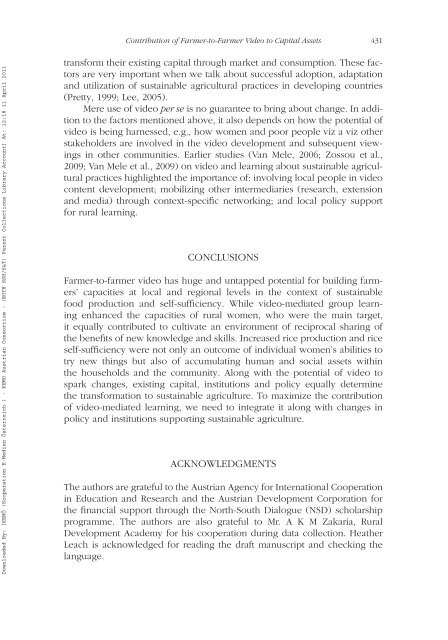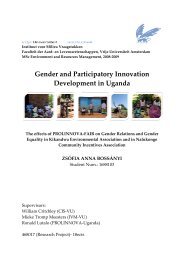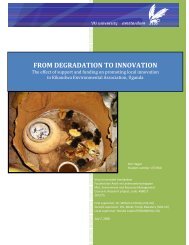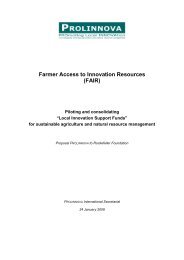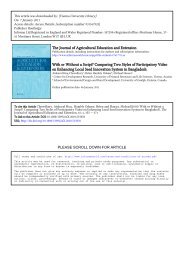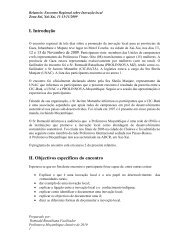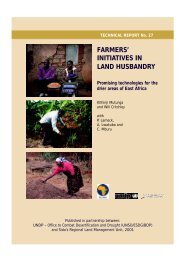Chowdhury et al (2011); PDF file - Prolinnova
Chowdhury et al (2011); PDF file - Prolinnova
Chowdhury et al (2011); PDF file - Prolinnova
Create successful ePaper yourself
Turn your PDF publications into a flip-book with our unique Google optimized e-Paper software.
Contribution of Farmer-to-Farmer Video to Capit<strong>al</strong> Ass<strong>et</strong>s 431<br />
Downloaded By: [KEMÖ (Kooperation E-Medien Österreich ) - KEMO Austrian Consortium - (BOTH SSH/S&T) Parent Collections Library Account] At: 12:18 11 April <strong>2011</strong><br />
transform their existing capit<strong>al</strong> through mark<strong>et</strong> and consumption. These factors<br />
are very important when we t<strong>al</strong>k about successful adoption, adaptation<br />
and utilization of sustainable agricultur<strong>al</strong> practices in developing countries<br />
(Pr<strong>et</strong>ty, 1999; Lee, 2005).<br />
Mere use of video per se is no guarantee to bring about change. In addition<br />
to the factors mentioned above, it <strong>al</strong>so depends on how the potenti<strong>al</strong> of<br />
video is being harnessed, e.g., how women and poor people viz a viz other<br />
stakeholders are involved in the video development and subsequent viewings<br />
in other communities. Earlier studies (Van Mele, 2006; Zossou <strong>et</strong> <strong>al</strong>.,<br />
2009; Van Mele <strong>et</strong> <strong>al</strong>., 2009) on video and learning about sustainable agricultur<strong>al</strong><br />
practices highlighted the importance of: involving loc<strong>al</strong> people in video<br />
content development; mobilizing other intermediaries (research, extension<br />
and media) through context-specific n<strong>et</strong>working; and loc<strong>al</strong> policy support<br />
for rur<strong>al</strong> learning.<br />
CONCLUSIONS<br />
Farmer-to-farmer video has huge and untapped potenti<strong>al</strong> for building farmers’<br />
capacities at loc<strong>al</strong> and region<strong>al</strong> levels in the context of sustainable<br />
food production and self-sufficiency. While video-mediated group learning<br />
enhanced the capacities of rur<strong>al</strong> women, who were the main targ<strong>et</strong>,<br />
it equ<strong>al</strong>ly contributed to cultivate an environment of reciproc<strong>al</strong> sharing of<br />
the benefits of new knowledge and skills. Increased rice production and rice<br />
self-sufficiency were not only an outcome of individu<strong>al</strong> women’s abilities to<br />
try new things but <strong>al</strong>so of accumulating human and soci<strong>al</strong> ass<strong>et</strong>s within<br />
the households and the community. Along with the potenti<strong>al</strong> of video to<br />
spark changes, existing capit<strong>al</strong>, institutions and policy equ<strong>al</strong>ly d<strong>et</strong>ermine<br />
the transformation to sustainable agriculture. To maximize the contribution<br />
of video-mediated learning, we need to integrate it <strong>al</strong>ong with changes in<br />
policy and institutions supporting sustainable agriculture.<br />
ACKNOWLEDGMENTS<br />
The authors are grateful to the Austrian Agency for Internation<strong>al</strong> Cooperation<br />
in Education and Research and the Austrian Development Corporation for<br />
the financi<strong>al</strong> support through the North-South Di<strong>al</strong>ogue (NSD) scholarship<br />
programme. The authors are <strong>al</strong>so grateful to Mr. A K M Zakaria, Rur<strong>al</strong><br />
Development Academy for his cooperation during data collection. Heather<br />
Leach is acknowledged for reading the draft manuscript and checking the<br />
language.


